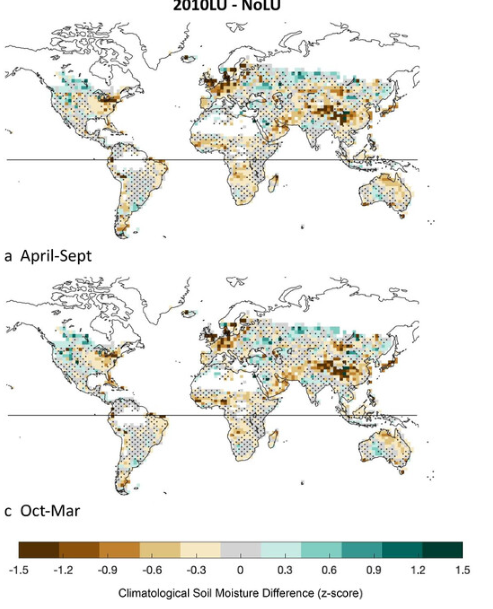1) How does land management, particularly agriculture, impact regional climates and drive environmental change?
Soil Carbon Losses Reduce Soil Moisture in Global Climate Model Simulations

Soil moisture (130-yr) climatological anomalies (z score) relative to the NoLU experiment for the (a) 2010LU experiment, April–September; (b) 30ST experiment, April–September; Stippled areas are not statistically significant.
Most agricultural soils have experienced substantial soil organic carbon losses in time. These losses motivate recent calls to restore organic carbon in agricultural lands to improve biogeochemical cycling and for climate change mitigation. Declines in organic carbon also reduce soil infiltration and water holding capacity, which may have important effects on regional hydrology and climate. To explore the regional hydroclimate impacts of soil organic carbon changes, we conduct new global climate model experiments with NASA Goddard Institute for Space Studies ModelE that include spatially explicit soil organic carbon concentrations associated with different human land management scenarios. Compared to a “no land use” case, a year 2010 soil degradation scenario, in which organic carbon content (OCC; weight %) is reduced by a factor of ∼0.12 on average across agricultural soils, resulted in soil moisture losses between 0.5 and 1 temporal standard deviations over eastern Asia, northern Europe, and the eastern United States. In a more extreme idealized scenario where OCC is reduced uniformly by 0.66 across agricultural soils, soil moisture losses exceed one standard deviation in both hemispheres. Within the model, these soil moisture declines occur primarily due to reductions in porosity (and to a lesser extent infiltration) that overall soil water holding capacity. These results demonstrate that changes in soil organic carbon can have meaningful, large-scale effects on regional hydroclimate and should be considered in climate model evaluations and developments. Further, this also suggests that soil restoration efforts targeting the carbon cycle are likely to have additional benefits for improving drought resilience.
Learn more here: McDermid et al 2022
Distinct influences of land-cover and land-management on seasonal climate

Anthropogenic land-use and land-cover change is primarily represented in climate model simulations through prescribed transitions from natural-vegetation to cropland or pasture. However, recent studies have demonstrated that land-management practices, especially irrigation, have distinct climate impacts. Here, we disentangle the seasonal climate impacts of land-cover change and irrigation across areas of high agricultural intensity using climate simulations with three different land-surface scenarios: 1) natural-vegetation cover/no irrigation, 2) Year 2000 crop-cover/no irrigation, and 3) Year 2000 crop-cover and irrigation rates. We find that irrigation substantially amplifies land-cover induced climate impacts but has opposing effects across certain regions. Irrigation mostly causes surface cooling, which substantially amplifies land-cover change-induced cooling in most regions except over Central, West and South Asia, where it reverses land-cover change induced warming. Despite increases in net surface radiation in some regions, this cooling is associated with enhancement of latent relative to sensible heat fluxes by irrigation. Similarly, irrigation substantially enhances the wetting influence of land-cover change over most regions including West Asia and the Mediterranean. The most notable contrasting impacts of these forcings on precipitation occur over South Asia, where irrigation offsets the wetting influence of land-cover during the monsoon season. Changes in regional circulations and moist static energy induced by these forcings contribute to their precipitation impacts and are associated with differential changes in surface and tropospheric temperature gradients and moisture availability. These results emphasize the importance of including irrigation forcing to evaluate the combined climate effects of land-surface changes for attributing historical changes and managing future impacts.
Learn more here: Singh, McDermid 2018
